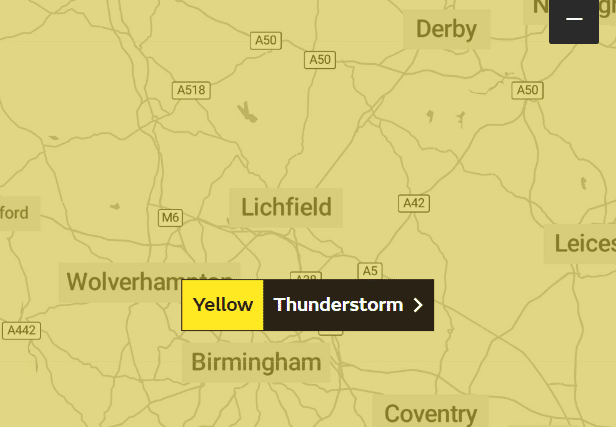Yellow weather warning for Birmingham: When to expect thunderstorms & torrential rain today (Monday)
and live on Freeview channel 276
A yellow weather warning is in place as thunderstorms and torrential downpours are expected in Birmingham today (Monday, June 12). The downpours may bring disruption to Birmingham along with other parts of England and Wales.
The yellow weather warning for thunderstorms in Birmingham has been issued between 12pm and 9pm. Heavy rainfall may cause some localised flooding, which could disrupt travel in the city, according to West Midlands Roads.
Advertisement
Hide AdAdvertisement
Hide AdThe MET office said the thunderstorms and torrential rain will be slow moving and intense, leading to some large accumulations with in excess of 3mm of rain in an hour for some locations - and the potential for 60-80mm or more in a few hours where thunderstorms align for a time. Frequent lightning and hail are likely to be additional hazards. The MET office has issued advice on travel during the difficult weather conditions.
West Midlands local authorities affected:
- West Midlands Conurbation - Birmingham, Solihull, Sutton Coldfield, and more
- Warwickshire
- Worcestershire
- Shropshire
- Staffordshire
- Stoke-on-Trent
- Telford and Wrekin
What to do if you fear your property is at risk of flooding
The government has issued as list of advice to check if your property is at risk of flooding. This includes the posssible causes of flooding tha thomes could be at risk of and how ot manage flood risk. It covers properties near rivers, reservoirs and surface water. You can also check the full details here Gov.uk.


What to do when driving in storms, rain and strong wind?
- Even moderate rain can reduce your ability to see and be seen. A good rule of thumb is ‘if it’s time for your wipers, it’s time to slow down’.
- If heavy downpours are expected, avoid starting your journey until it clears.
- If you can, choose main roads, where you are less likely to be exposed to fallen branches and debris and flooding.
- Use dipped headlights if visibility is seriously reduced.
- Gusts of wind can unsettle vehicles – grip your steering wheel firmly with both hands. This is particularly important when planning to overtake.
- Keep an eye out for gaps between trees, buildings or bridges over a river or railway – these are some of the places you are more likely to be exposed to side winds. Ensure that you maintain enough room either side of your vehicle so you can account for it being blown sideways.
- Roads will be more slippery than usual in wet weather – be sure to give yourself more time to react when approaching a hazard. Increase your following gap to at least four seconds from the moving traffic in front.
- Keep your eyes peeled on the road at all times as spray from other vehicles can suddenly reduce your visibility. Remember it affects others too, so anticipate their actions and be prepared.
What to do when the road is flooded?
- If the road is flooded, turn around and find another route. The number one cause of death during flooding is driving through flood water, so the safest advice is turn around, don’t drown.
- Although the water may seem shallow, just 12 inches (30cm) of moving water can float your car, potentially taking it to deeper water from which you may need rescuing.
- Flood water also contains hidden hazards which can damage your car, and just an egg-cupful of water sucked into your car’s engine will lead to severe damage.
- Never drive through flood water. Turn around.
Keep an eye out for cyclists, motorcyclists and pedestrians
- Remember to give vulnerable road users including cyclists, motorcyclists and pedestrians more room than usual. They are more likely to be blown around by side winds – always keep a safe distance.
Comment Guidelines
National World encourages reader discussion on our stories. User feedback, insights and back-and-forth exchanges add a rich layer of context to reporting. Please review our Community Guidelines before commenting.
